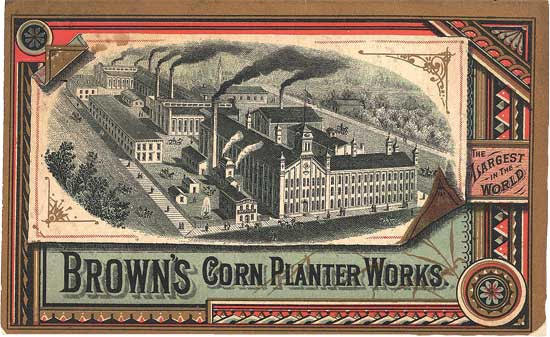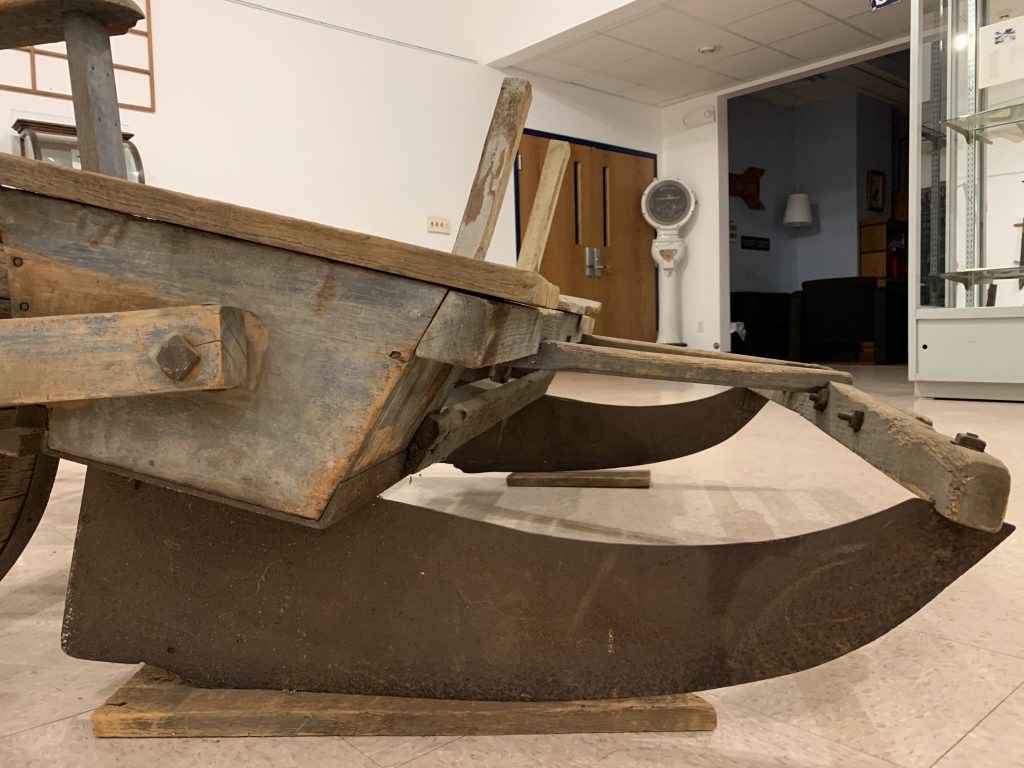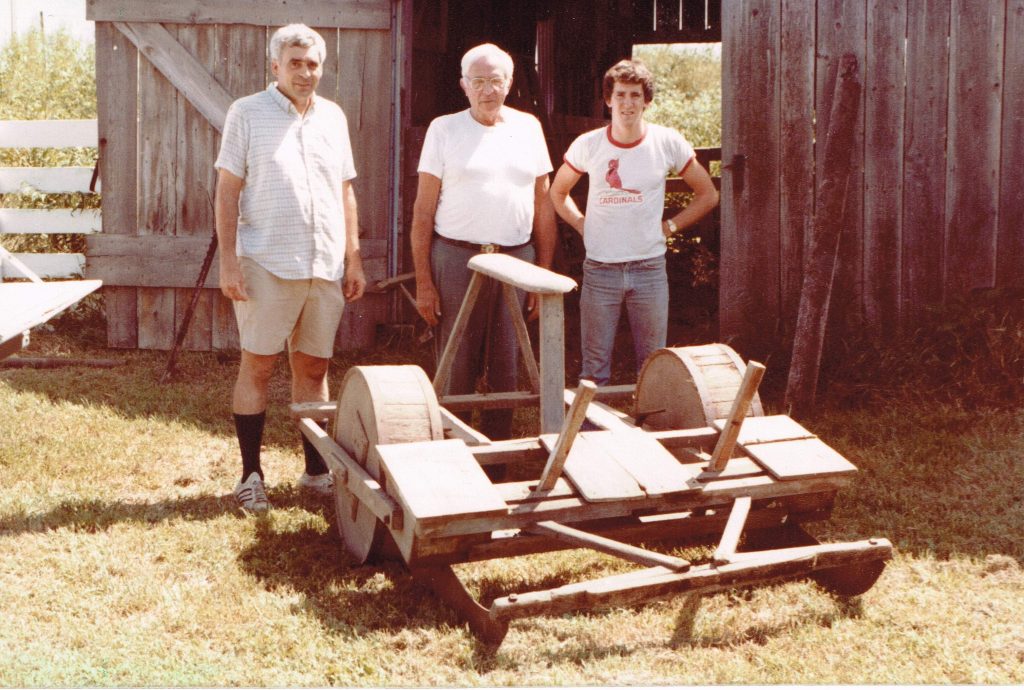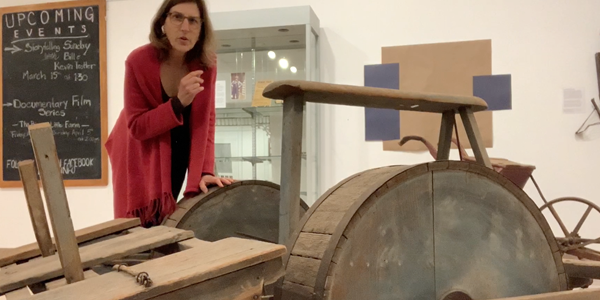This short video give an up-close look at two artifacts from the museum’s collection that were used to plant corn in the mid-1800s.
The Brown Corn Planter
Using the hand planters a farmer could only plant about one acre of corn per day, limiting their overall production to about ten acres of corn per year. Farmers of the 1800s planted corn in a check pattern different from what is seen in today’s fields. The method was to place three or four seeds in hills equidistant from each other in all directions, forming a “check” pattern. The typical spacing was 42 inches to accommodate a horse or mule for cultivation. This type of planting allowed corn to be cultivated in both directions, making weed control much easier.
In 1853, George Brown of Knox County dramatically changed corn production in the Midwest with the introduction of his horse-drawn corn planter. Two early version of which is on display here. George W. Brown, an experienced carpenter, as well as a farmer who had an interest in creating devices that made farm life a little easier. One of his first efforts to combine the operations of planting corn was a seed hopper with a mechanical device for dropping the corn attached to a shovel plow to open a trench and a log rolling behind to cover the seed. After further improvements, in 1853 Brown was awarded a patent for a machine that he had used successfully the previous two years.
Brown made 12 planters in 1853, 100 in 1854, and triple that the next year. The new machines were not immediately accepted by farmers, although those who saw it at work said it “would run very prettily through the field.” They express concerns about the seed being damaged, planted at the proper depth, being covered correctly, as well as proper placement in the checker pattern.

As the machine became proven to work, Brown doubled production to 600 machines in 1856 and then to a 1,000 the next year. As the market for the planters increased other companies began making similar machines. After a number of lawsuits initiated by Brown, the U.S. Supreme Court ruled in his favor, recognizing George W. Brown as the inventor and patent holder for the corn planter.
By the end of the Civil War, Brown employed from 130 to 230 employees and had a network of dealers to distribute the planters across the country. In 1880, the firm was reorganized as Geo. Brown & Co. with a capitalization of $300,000. Later the company expanded to manufacture other types of farm machinery. Brown actively managed the company until 1892 just three years before his death in 1895.
How it worked
Although George Brown didn’t invent them, row markers, as well as automatic check-row devices used a wire or rope stretched across the field with knots at regular intervals to actuate the droppers which released the seed into the ground.
Brown patented a semi-rotating seed plate for the hopper bottom with openings of various sizes for various seeds, and during the 1870s Deere & Mansur further perfected the rotary plate principle, one that was used on planters well into the 1960s.

Prior to planting a field, a wagon was driven across the field to mark the row spacing. Two people operated the machine: One man drove while riding on the bench in back, while another person, usually a young son, rode on the seat in front. When the planter crossed the row marks in the field, the person in front operated the lever, which caused seeds to drop out of the boxes and into a furrow cut open by the shoe-blades in front. The flat wheels then closed the row as they passed over. Brown’s machine allowed farmers to plant as much as ten to twenty acres of corn in a day, dramatically increasing the size of fields and corn yields on the farm.
About George Washington Brown
George Washington Brown was born October 29, 1815, in Saratoga County in eastern New York. George’s father, Valentine, was a farmer who died when his son was young. At the age of 14 George went to live with an older brother who was a carpenter where he learned carpentry and joinery.
In 1835 Brown married Maria Turpening and a year later moved to Warren County in Illinois, reportedly with just $28 in cash. They had two daughters and a son. George traded his team of horses for 80 acres of land and began to farm. He continued to use his carpentry skills, building many houses for his neighbors and repairing wooden implements.
During these years he also tinkered in his shop, creating devices that made farm life a little easier, including a cultivator and an improved churn. Using his carpentry skills and knowledge of farming, his idea to combine the steps of planting corn, cutting the soil, dropping the seed, and covering it over, that leads to a new business opportunity. In 1853 he founded a company to make his patented corn planter, and in 27 years he worked to build a successful manufacturing company with a capital of $300,000.
Brown was also active in his home town of Galesburg, Illinois, serving as mayor for one year in 1878 and providing capital for the expansion of the region’s railroads. Dedicated to his work, he was an active participant in the business until three years before his death in 1895.
Jarvis N. Burr

This early Brown Corn Planter was donated to the Western Illinois Museum in 1982 by the Burr Family. The planter has been in the family since it was used by Jarvis N. Burr who came to Illinois from Higganum, Connecticut, in the early 1850s. He purchased a farm in 1854 in Durham Township in Hancock County, Illinois. His son, Dennis R. Burr remembers riding the corn planter when he was eight years old in 1871. His job was to ride the jump seat and work the hand levers to drop the corn. His father rode on the seat and drove the horses. This early model Brown planter had no check wire or check rope to indicate where to release the seed. A long bar with spaced teeth was used to mark off the field crossways before planting. The young boy would then know where to drop the seed.
The Burr Family still owes farms the land purchased by Jarvis and is being farmed by its fourth generation.
